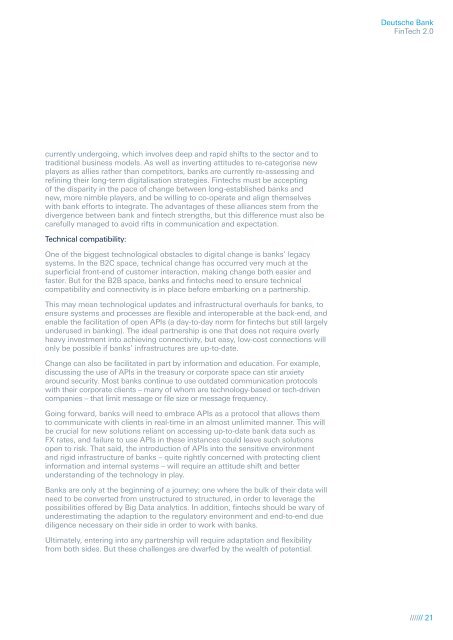FinTech 2.0
YKHHI
YKHHI
Create successful ePaper yourself
Turn your PDF publications into a flip-book with our unique Google optimized e-Paper software.
Deutsche Bank<br />
<strong>FinTech</strong> <strong>2.0</strong><br />
currently undergoing, which involves deep and rapid shifts to the sector and to<br />
traditional business models. As well as inverting attitudes to re-categorise new<br />
players as allies rather than competitors, banks are currently re-assessing and<br />
refining their long-term digitalisation strategies. Fintechs must be accepting<br />
of the disparity in the pace of change between long-established banks and<br />
new, more nimble players, and be willing to co-operate and align themselves<br />
with bank efforts to integrate. The advantages of these alliances stem from the<br />
divergence between bank and fintech strengths, but this difference must also be<br />
carefully managed to avoid rifts in communication and expectation.<br />
Technical compatibility:<br />
One of the biggest technological obstacles to digital change is banks’ legacy<br />
systems. In the B2C space, technical change has occurred very much at the<br />
superficial front-end of customer interaction, making change both easier and<br />
faster. But for the B2B space, banks and fintechs need to ensure technical<br />
compatibility and connectivity is in place before embarking on a partnership.<br />
This may mean technological updates and infrastructural overhauls for banks, to<br />
ensure systems and processes are flexible and interoperable at the back-end, and<br />
enable the facilitation of open APIs (a day-to-day norm for fintechs but still largely<br />
underused in banking). The ideal partnership is one that does not require overly<br />
heavy investment into achieving connectivity, but easy, low-cost connections will<br />
only be possible if banks’ infrastructures are up-to-date.<br />
Change can also be facilitated in part by information and education. For example,<br />
discussing the use of APIs in the treasury or corporate space can stir anxiety<br />
around security. Most banks continue to use outdated communication protocols<br />
with their corporate clients – many of whom are technology-based or tech-driven<br />
companies – that limit message or file size or message frequency.<br />
Going forward, banks will need to embrace APIs as a protocol that allows them<br />
to communicate with clients in real-time in an almost unlimited manner. This will<br />
be crucial for new solutions reliant on accessing up-to-date bank data such as<br />
FX rates, and failure to use APIs in these instances could leave such solutions<br />
open to risk. That said, the introduction of APIs into the sensitive environment<br />
and rigid infrastructure of banks – quite rightly concerned with protecting client<br />
information and internal systems – will require an attitude shift and better<br />
understanding of the technology in play.<br />
Banks are only at the beginning of a journey; one where the bulk of their data will<br />
need to be converted from unstructured to structured, in order to leverage the<br />
possibilities offered by Big Data analytics. In addition, fintechs should be wary of<br />
underestimating the adaption to the regulatory environment and end-to-end due<br />
diligence necessary on their side in order to work with banks.<br />
Ultimately, entering into any partnership will require adaptation and flexibility<br />
from both sides. But these challenges are dwarfed by the wealth of potential.<br />
////// 21


